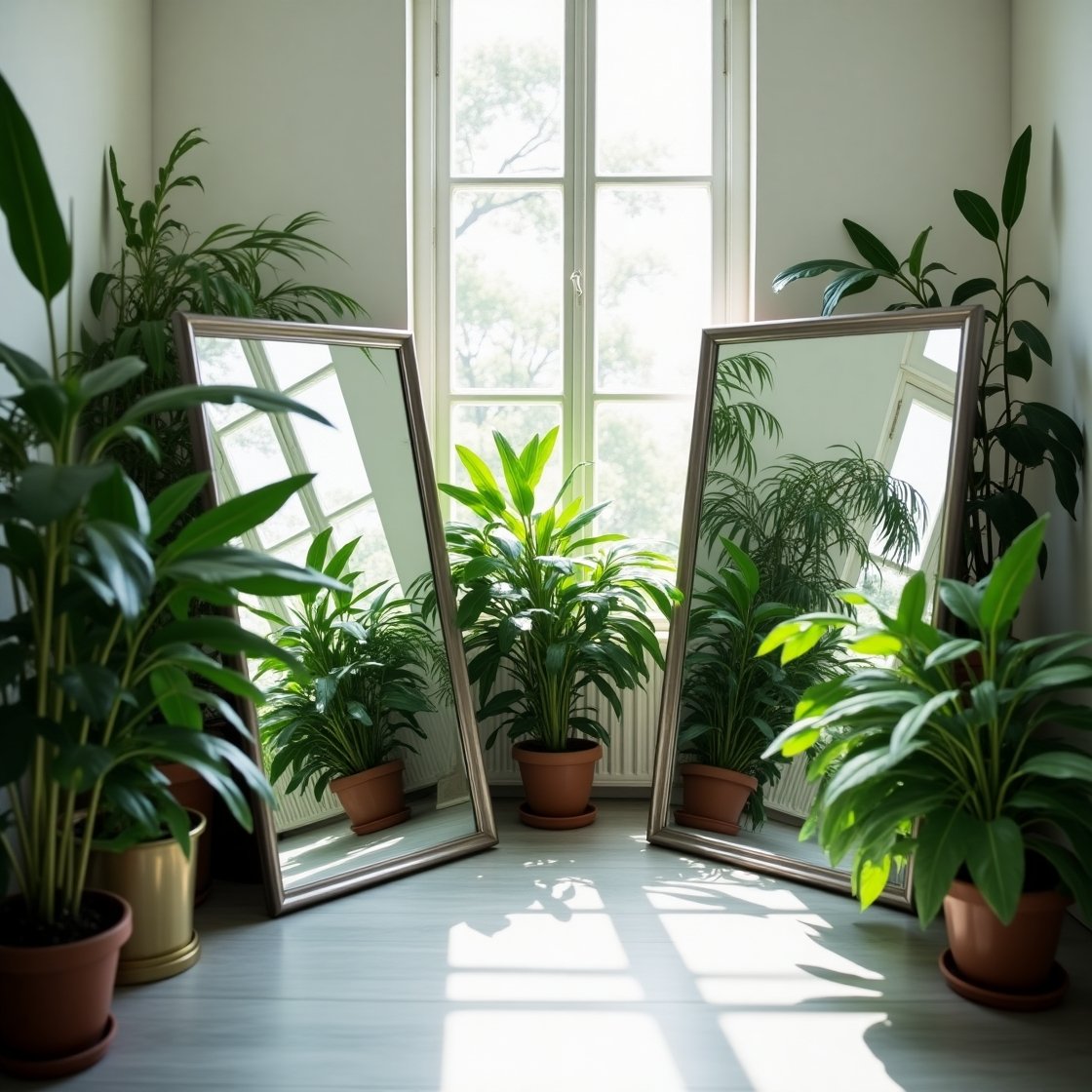Mirrors have long been considered a design trick to make rooms appear bigger and brighter. When combined with the lush greenery of indoor plants, mirrors can do even more—they amplify natural beauty, bounce light across the room, and double the visual impact of your favorite foliage. In small apartments or tight spaces, mirrors paired with plants can work magic.
This article explores practical and stylish ways to use mirrors to reflect plants and make your space feel more expansive and harmonious.
Why Use Mirrors in Plant Decor?
Adding mirrors into your plant-filled space isn’t just about appearance. Here are the main benefits:
- Visual Expansion: Mirrors reflect walls and windows, giving the illusion of depth and openness.
- Light Amplification: They bounce natural light around the room, helping plants thrive in darker corners.
- Aesthetic Harmony: The reflection of greenery softens hard edges and creates a calming, balanced look.
- Highlighting Decor: Mirrors act like spotlights for your favorite plant vignettes, doubling their impact.
In short, mirrors bring a mix of function and flair that perfectly complements indoor gardening.
Best Mirror Styles for Plant Reflection
Choosing the right mirror is essential to make the most of your space and match your interior theme. Here are the most effective mirror types for working with plants:
1. Floor-Length Mirrors
Great for bedrooms, entryways, and living rooms. Place behind a tall plant like a fiddle leaf fig or monstera to double its visual presence and reflect light vertically.
2. Round and Oval Mirrors
These soften angular rooms and pair well with bushy plants or trailing vines like pothos or philodendron. Their shape echoes nature and brings fluidity to decor.
3. Arched or Windowpane Mirrors
Perfect for rustic, vintage, or industrial interiors. They mimic the feel of a window, bringing more perceived depth and acting as an additional light source when reflecting plants.
4. Framed Mirrors with Natural Materials
Use mirrors with rattan, wood, or bamboo frames to align with earthy aesthetics. These blend effortlessly with woven baskets and natural plant pots.
Strategic Mirror Placement with Plants
Where and how you place your mirror makes all the difference. Use these tips for optimal effect:
Opposite a Window
Placing a mirror directly across from a window maximizes daylight and reflects outdoor greenery, making your space feel garden-like even indoors.
Behind a Plant Display
Whether it’s a plant shelf or a single statement plant, positioning a mirror behind creates a stunning visual echo. It adds movement, making the foliage feel fuller and more abundant.
Near Corners
Dark corners benefit from a mirror paired with a light-loving plant. It brightens the area and adds a new layer of texture without adding furniture.
Above Furniture
Placing a mirror above a sideboard or console table with plants helps unify the display. It reflects the plant arrangements and adds symmetry.
Combining Mirrors and Hanging Plants
One of the most underused techniques is pairing mirrors with hanging plants. Here’s how to make it work:
- Hang mirrors behind macrame plant holders to reflect trailing vines like ivy or pothos.
- Use staggered heights to create dynamic movement in the reflection.
- Place LED string lights around the mirror for evening ambiance.
This setup works beautifully in bedrooms, living rooms, or balconies with vertical space.
Mirror Size vs. Plant Size: Finding Balance
Balance is key when combining large reflective surfaces with living greenery.
- Large Mirrors: Use with tall plants or a group of medium-sized plants to avoid feeling empty.
- Small Mirrors: Best paired with one or two compact or trailing plants.
- Mirror Wall: Create a gallery with a mix of mirror sizes and small potted plants for a bohemian or eclectic look.
Pro Tip: Always clean mirrors regularly—dust and water marks from nearby plant misting can reduce their shine.
Safety and Maintenance
When combining mirrors and plants, a few practical considerations go a long way:
- Avoid direct harsh sunlight: A mirror can concentrate light and burn nearby plants.
- Secure mirrors: Use wall anchors or adhesive strips to keep mirrors stable, especially in homes with pets or children.
- Ventilation: Make sure moisture from watering doesn’t collect behind wall mirrors — especially in humid rooms.
Creating Themes with Reflections
You can use mirrors to help define the feel of a room:
- Tropical Retreat: Palm or monstera plants with bamboo mirrors.
- Minimalist Zen: A single snake plant reflected in a frameless mirror.
- Urban Jungle: Multiple plants of varying heights reflected in an industrial mirror.
Each reflection adds depth and an additional perspective of the same plant arrangement, giving your room a multi-dimensional look.
Plants That Look Amazing in Mirrors
Some plants are especially striking when reflected:
- Monstera Deliciosa: Its unique, split leaves create intricate mirror patterns.
- String of Pearls: Dramatic trailing plant that adds vertical elegance.
- Rubber Plant: Its glossy, dark leaves catch light and look sculptural.
- Calathea: The leaf patterns and movements reflect beautifully.
- Philodendron Brasil: Color-contrasted foliage creates stunning mirrored outlines.
Final Thoughts: Let Nature Reflect Back at You
Mirrors don’t just open up your home visually — they open your eyes to the natural beauty you’ve curated within. When used thoughtfully, mirrors double the joy of your green sanctuary.
By reflecting your plants, you emphasize calmness, rhythm, and a living environment that feels bigger and more alive. Even the smallest apartment can be transformed into a lush, light-filled retreat using nothing more than a few leafy friends and a well-placed mirror.
